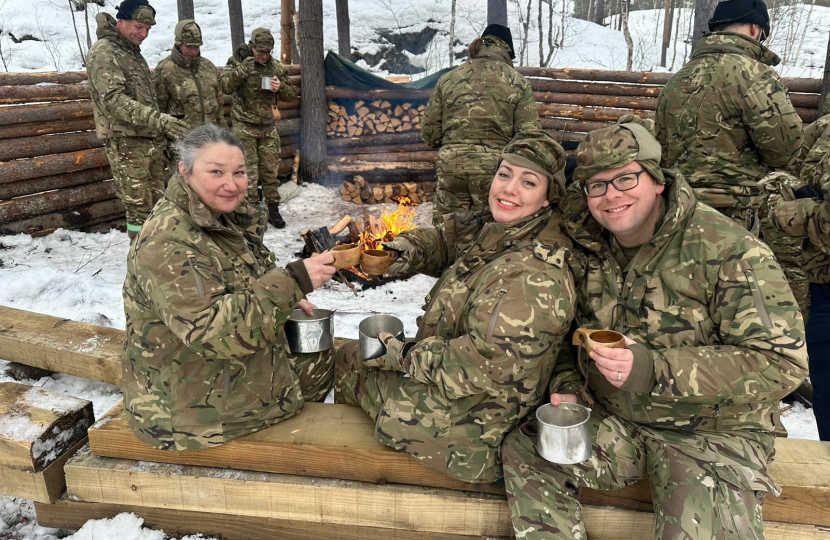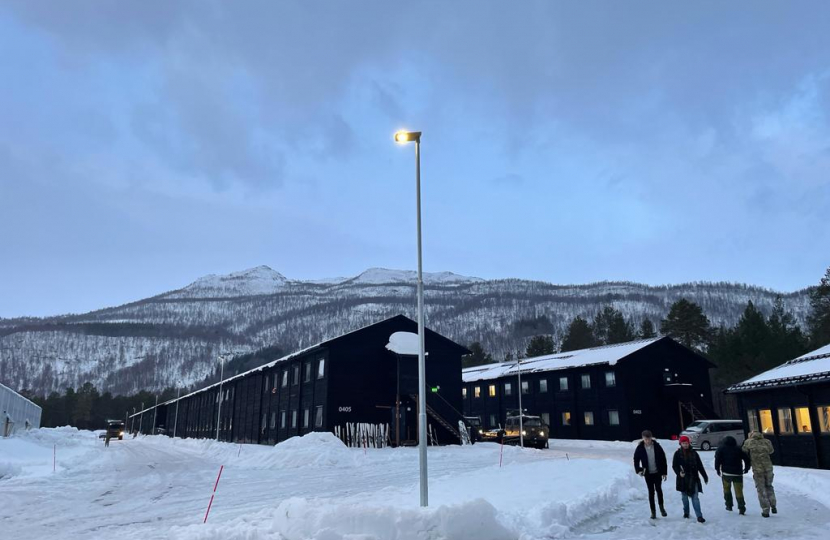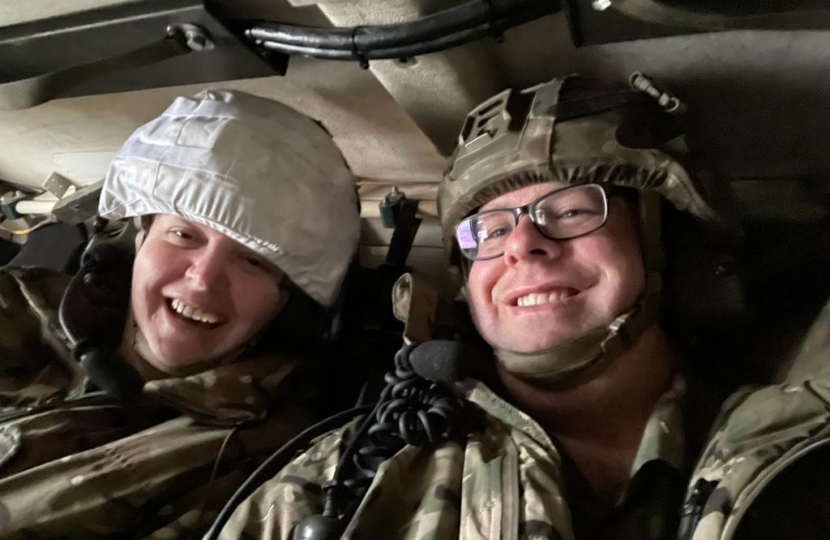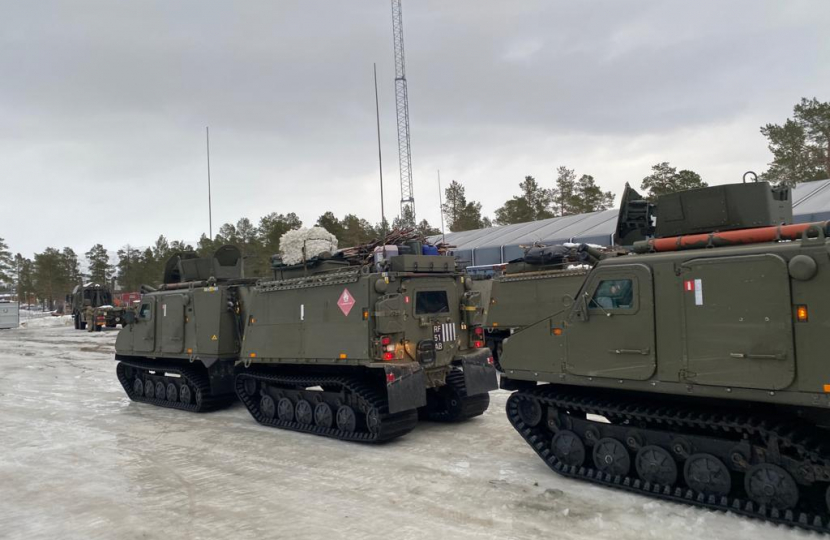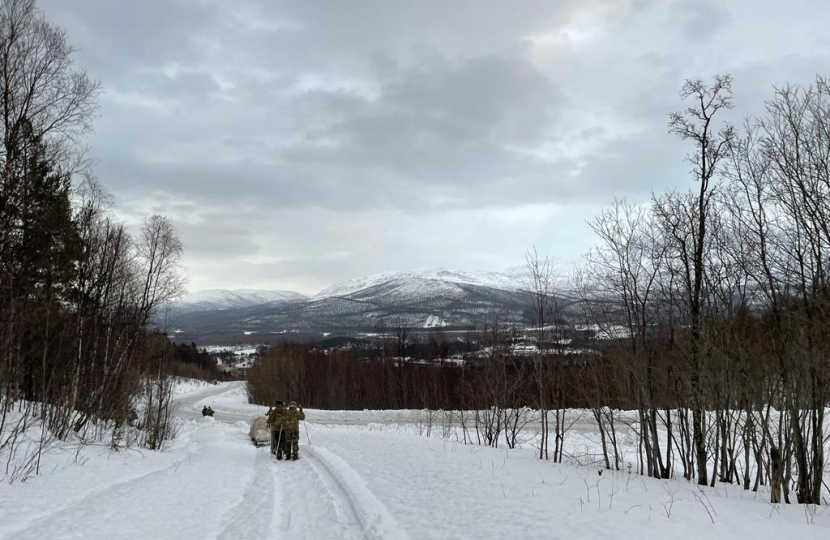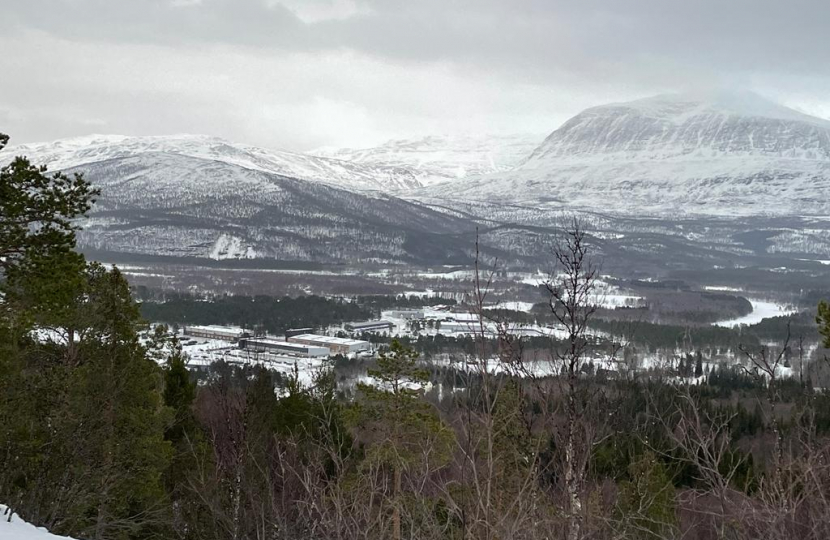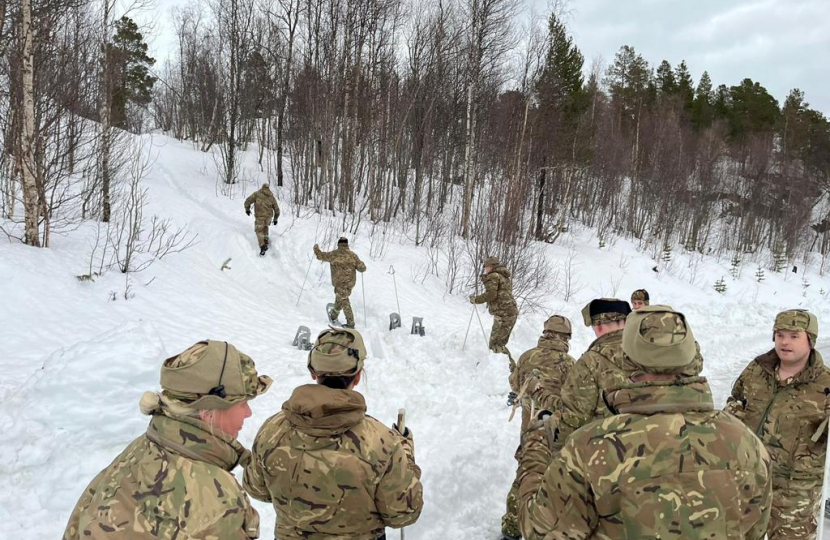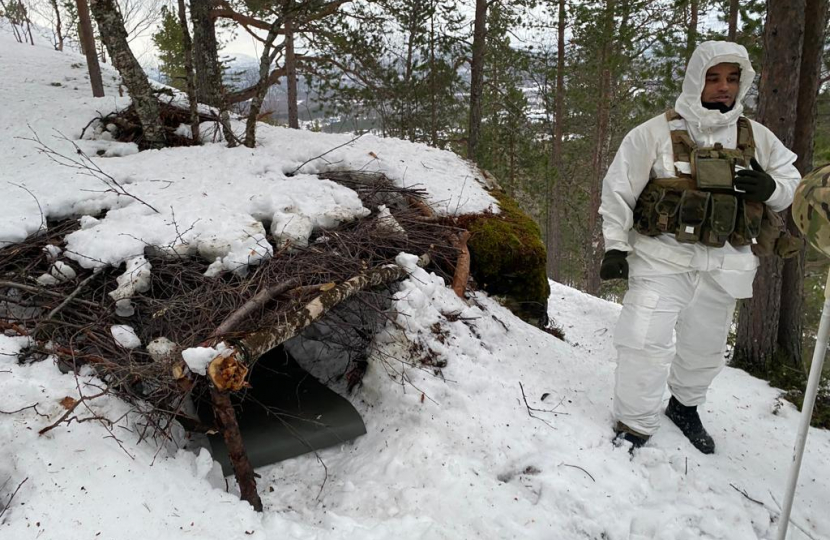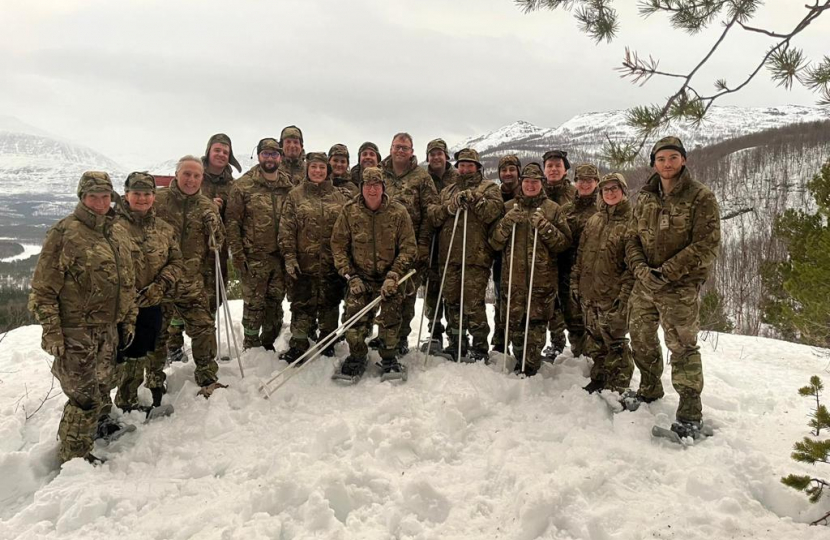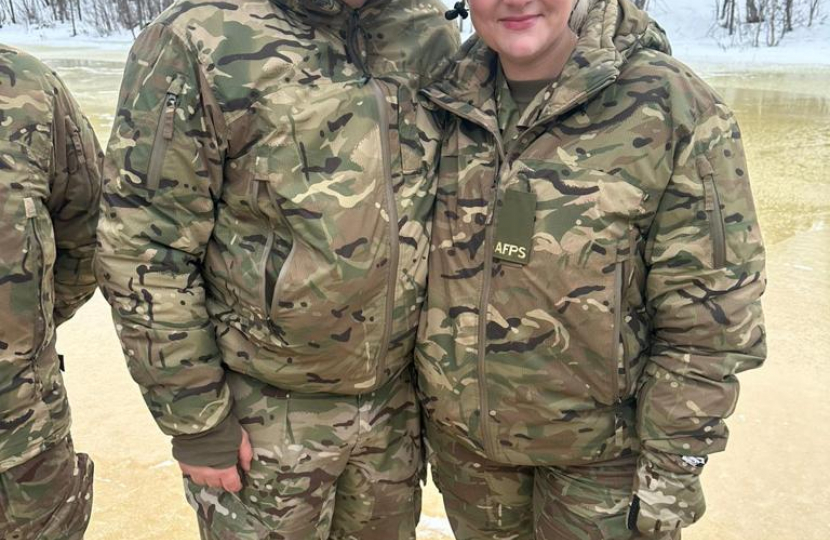Hello from Copenhagen, where I’ve been stranded by a storm trying to get back to the UK. I hope you won’t mind a bonus newsletter, but I’ve just spent the past week (fear not - it’s recess, Parliament wasn’t sitting!) in the Arctic Circle with the Royal Marines at their extreme weather training base, and I wanted to let you know why, and what I got up to.
The AFPS
As you may be aware, I’m participating this year in the Armed Forces Parliamentary Scheme (AFPS), with my chosen service being the Royal Navy. The AFPS was established because the number of MPs from a services/military background has declined over recent years, and the scheme helps to give Parliamentarians a level of experience and knowledge they may not otherwise get. It’s cross party and both Lords and MPs can do it. It runs like an academic year from September to July, with two or three visits every month.
Brilliantly, the scheme works on a number of levels. You receive high level strategic briefings on threats, capabilities and where the different bits of the military are looking to evolve. You meet military personnel of all ranks and have a chance to ask anything. But - crucially - you also stay in the same accommodation drink in the same mess and eat the same food as those on base, meaning it’s no frills and unvarnished. We are encouraged to speak to everyone on base, from the medics, trainees, cleaners and support staff through to the Commanding Officers. We hear everything that is good and bad about our forces, and meet some of the most incredible people our country has to offer.
The Royal Navy scheme undertakes about 40 visits over the year, with additional lectures and briefings in London. Incidentally if you’ve seen me in the constituency on a Saturday recently and I’ve looked tired, it’s probably because I’ve been coming home from London via the south coast or Scotland, as we don’t have a large Royal Navy footprint in the East Midlands! But I wanted to do the scheme this year because of what is happening in the world. The Russian invasion of Ukraine is affecting everything we do, but the growing influence of China on world events is a strong undertone as well. I owe it to my constituents to better educate myself on our forces, and to understand our capabilities and approach.
The scheme is undoubtedly the best thing I’ve ever done. There have been some fun moments (going on a nuclear submarine, riding a chinook over central London, learning to fire a rifle) but the three best things from my perspective have been 1) developing an understanding of our strategic approach to defence 2) meeting the brilliant men and women who do serve in our forces and understanding what motivates them and 3) seeing the culture of our forces across the country and seeing how each base is reflective of local leadership and national priorities. It’s the kind of experience money can’t buy, and is invaluable for an MP.

Why Norway?
Norway is a major military ally of the UK and a member of NATO. Simply, from a maritime perspective, if Russia were to go to war with NATO, Norway is likely to be the first country to be invaded. The reason is simply to do with geography; Russia’s northern fleet sits around 100 miles east of Norway’s top right edge, and the easiest pathway to the Atlantic sits alongside Norway, particularly for submarines. If Norway were to fall under Russian control early in any war, it would give them unfettered access to the Atlantic for their submarines and make any American involvement in any conflict considerably more challenging. Already, British submarines, helicopters and ships patrol the waters in that area regularly to prevent nefarious Russian actions.
Sitting to the east of Norway is Sweden and Finland, two countries that have previously relied on relative neutrality in foreign affairs. Yet the horrendous actions of Russia towards the Ukraine have made them reconsider, and both have applied for NATO membership. Whilst that is ongoing, the next bit of what I write may change significantly over the coming decade.
Our visit was predominantly to Camp Viking, a base within the arctic circle in North Norway. There are several hundred Royal Marines on base, with bases for the Dutch and the Americans (alongside the Norwegians) nearby. In short, there are several thousand NATO personnel there, very much at Norway’s request. Camp Viking is owned by the Norwegians, but given to the Royal Marines on a ten-year agreement. It serves as the extreme cold weather training base for around five months of the year, but we don’t currently have the manpower to operate it all year round.
The conditions are usually incredibly harsh, with temperatures often reaching minus 20 and presenting challenges from getting vehicles around in snow and ice through to needing to operate with different kit and being able to survive in extreme winds and snow. To put it into perspective, the past week has been relatively mild here (some parts of England were colder on one day we were there) but still two of our delegation (I was one!) had falls because of the underfoot conditions and one member got early trench foot because the socks they were wearing weren’t breathable. In these circumstances, the right kit is essential, as is a proper understanding of the conditions and how to operate. It was made clear to us that one tour here is barely enough for a base knowledge, you need to come back several times to reach an acceptable level.
The Russians clearly have experience of fighting in these conditions and temperatures, and it is essential we have the same. The Royal Marines are the UK specialists in these conditions, but the paras are also upping their presence locally. Given the nature of the conflict in Ukraine, this training is absolutely essential right now, and I was heartened to hear that the Royal Marines are also involved in training the Ukrainian troops who are coming over to the UK. Some of our guys out in Norway are incredibly experienced in the challenges these terrains and conditions present, and it’s heartening that we’re passing on that knowledge.
NATO undertakes joint exercises in Norway to practice techniques and plans and those on base are working towards a joint exercise in March with our allies.

Camp Viking
Over the past week we’ve received a number of briefings on the strategic importance of Norway, but also how it fits into the wider reorganization that is happening within both the Royal Navy and the Royal Marines specifically. We were given a mandatory briefing on extreme cold weather survival techniques and clothing, on our work with our allies locally, on the challenges of providing medical support in such remote conditions, on the technology and equipment we use and on the work of many of the teams that are based on camp.
We had a chance to visit Clockwork Camp, the local home of the Joint Helicopter Command (which works across all 3 services, so with British Armed Forces and Royal Air Force personnel present as well). I cannot imagine being a helicopter mechanic trying to prepare a machine for flight in minus 25 conditions with snowfall and gale force winds, but that is precisely why we have a training facility out there. We were given the huge privilege of meeting many of the people who serve on base and then flown back to Viking on a Merlin, an experience I’ll never forget.
We were shown survival training for those who suffer an accident during an operation. In a simulation, we saw a two-man team come under attack and one of the team fall into icy water, and what they have to do to protect themselves and survive in those conditions. Every Royal Marine who trains here goes into the icy water, a thought that fills me with dread. We were shown how they build shelters from things that are readily available, how you can repurpose your equipment to start a fire (essential if you’ve fallen in the ice) and also how a team of six men with nearly a tonne of equipment can make themselves invisible and survive for ten days.
We saw the The Royal Engineers demolition team operating, a live demonstration of one of the dogs being used to hunt down an enemy in these conditions and how communications can both be sent and intercepted without leaving a trace. We travelled in BVs and Vikings, equipment that is purpose built for those conditions, and given the chance to drive cars and land rovers on sheets of ice and deep snow. We were allowed to fire rifles on the range and met with the mechanics who have to keep the vehicles moving or the base will grind to a halt.
We also got to meet with Brigadier Duncan Forbes, who I also met on a visit to Plymouth last year, to receive a strategic overview of his work and the relationship with the Norwegians. It was heartening to hear that the presence of our delegation was helpful and welcomed, both to our troops locally but also in our relations with the Norwegian government. I offered - and I hope we can see this through - to provide further follow up on that front, as we didn’t get a chance to meet with the Norwegians whilst we were out here.

Conclusions
My most overwhelming takeaway is that the Royal Marines are the very best of Britain. The men and women we got to spend time with - of all ranks and often from other bits of the Royal Navy and British Armed Forces - are just exceptional. I was privileged to give the vote of thanks to the Commanding Officer at the end of the trip and could barely contain my emotions when I said that I’d never been so proud of my country. To spend a week with them, to chat so candidly with dozens of them and to have the privilege of seeing them train, living with them and drinking with them (and losing quite badly at table football) is something I’ll never forget. A big part of the scheme is that they can say anything to us in total confidence, but we always follow up on the most important issues.
The developments with Sweden and Finland wanting to join NATO does present an interesting development for our presence in the region. Russia’s increasing unpredictability makes NATO cooperation, interoperability and resourcing more important than it has been in a long time, but we cannot take our eyes off of other challenges around the globe.
That being said, Britain’s relationship with Norway is considerably more important than I had previously realised, and something I plan to read up on further. Camp Viking is not a secret and is a long way from the Russian border but provides an ideal training ground for our forces. It is a beautiful part of the world where we got to see the Northern Lights, but conditions are challenging oh the best days (try walking on sheets of ice or trudging through snow for hours on end) and change very quickly. Nearby, the Russian forces have - according to publicly available information - lost nearly two thirds of their forces from their northern brigade in Ukraine. But their presence remains an ongoing challenge that needs considerable strategic thought.
Finally, a key takeaway from this week is the constant clamour to send equipment to Ukraine, most recently fighter jets. This is much more complicated than initially meets our eye. I think all of us stand with Ukraine and support them in every possible way. We want to do all we can. But any military equipment requires knowledge on how to operate and on how to maintain, and with some bits (planes and helicopters especially) that knowledge requires years of practice. We must be very careful about two factors: 1) ensuring the equipment we send can and will be used easily and 2) to ensure our forces have the equipment they need should the worse happen. It’s a difficult balancing act but be careful of the headlines on what we should send and how easy it Will be. The full story is much more complex.
Right, I’ve just found out my - second - flight has been delayed and I’m off to buy a scotch. Don’t ever fly SAS Airlines, they make Ryanair seem like NASA. I hope this special newsletter has been helpful and apologies for any mistakes, I’m typing it on notes on my phone whilst wondering around Copenhagen airport.
Best,
Mark


